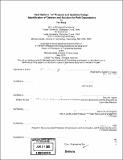| dc.contributor.advisor | Richard de Neufville. | en_US |
| dc.contributor.author | Wang, Tao, 1973- | en_US |
| dc.contributor.other | Massachusetts Institute of Technology. Engineering Systems Division. | en_US |
| dc.date.accessioned | 2006-02-02T18:54:45Z | |
| dc.date.available | 2006-02-02T18:54:45Z | |
| dc.date.copyright | 2005 | en_US |
| dc.date.issued | 2005 | en_US |
| dc.identifier.uri | http://hdl.handle.net/1721.1/31167 | |
| dc.description | Thesis (Ph. D.)--Massachusetts Institute of Technology, Engineering Systems Division, 2005. | en_US |
| dc.description | Includes bibliographical references (p. 289-298). | en_US |
| dc.description.abstract | This research develops a comprehensive approach to identify and deal with real options in" projects, that is, those real options (flexibility) that are integral parts of the technical design. It represents a first attempt to specify analytically the design parameters that provide good opportunities for flexibility for any specific engineering system. It proposes a two-stage integrated process: options identification followed by options analysis. Options identification includes a screening and a simulation model. Options analysis develops a stochastic mixed-integer programming model to value options. This approach decreases the complexity and size of the models at each stage and thus permits efficient computation even though traditionally fixed design parameters are allowed to vary stochastically. The options identification stage discovers the design elements most likely to provide worthwhile flexibility. As there are often too many possible options for systems designers to consider, they need a way to identify the most valuable options for further consideration, that is, a screening model. This is a simplified, conceptual, low-fidelity model for the system that conceptualizes its most important issues. As it can be easily run many times, it is used to test extensively designs under dynamic conditions for robustness and reliability; and to validate and improve the details of the preliminary design and set of possible options. The options valuation stage uses stochastic mixed integer programming to analyze how preliminary designs identified by the options identification stage should evolve over time as uncertainties get resolved. Complex interdependencies among options are specified in the constraints. | en_US |
| dc.description.abstract | (cont.) This formulation enables designers to analyze complex and problem-specific interdependencies that have been beyond the reach of standard tools for options analysis, to develop explicit plans for the execution of projects according to the contingencies that arise. The framework developed is generally applicable to engineering systems. The dissertation explores two cases in river basin development and satellite communications. The framework successfully attacks these cases, and shows significant value of real options "in" projects, in the form of increased expected net benefit and/or lowered downside risk. | en_US |
| dc.description.statementofresponsibility | by Tao Wang. | en_US |
| dc.format.extent | 337 p. | en_US |
| dc.format.extent | 14812215 bytes | |
| dc.format.extent | 14855847 bytes | |
| dc.format.mimetype | application/pdf | |
| dc.format.mimetype | application/pdf | |
| dc.language.iso | eng | en_US |
| dc.publisher | Massachusetts Institute of Technology | en_US |
| dc.rights | M.I.T. theses are protected by copyright. They may be viewed from this source for any purpose, but reproduction or distribution in any format is prohibited without written permission. See provided URL for inquiries about permission. | en_US |
| dc.rights.uri | http://dspace.mit.edu/handle/1721.1/7582 | |
| dc.subject | Engineering Systems Division. | en_US |
| dc.title | Real options "in" projects and systems design : identification of options and solutions for path dependency | en_US |
| dc.type | Thesis | en_US |
| dc.description.degree | Ph.D. | en_US |
| dc.contributor.department | Massachusetts Institute of Technology. Engineering Systems Division | |
| dc.identifier.oclc | 61232843 | en_US |
